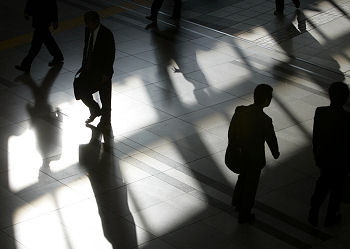Global warming alarmists may want to expedite their efforts to hamstring the global economy with greenhouse gas regulation.
A new study touted as showing that we’re not sufficiently panicky about manmade carbon dioxide emissions actually supports the exact opposite conclusion. “Warnings about global warming may not be dire enough, according to a climate study that describes a runaway-train acceleration of industrial carbon dioxide emissions,” USA Today shrieked this week. The study authors reported in the Proceedings of the National Academy of Sciences that the rate of manmade carbon dioxide emissions was three times greater during 2000 to 2004 than during the 1990s.
Since increasing atmospheric carbon dioxide levels allegedly are causing global warming, the new study must mean that global temperatures are soaring even faster now than they did during the 1990s, right? Wrong, according to the most recent data from the U.S. Department of Commerce’s National Climatic Data Center.By overlaying the atmospheric carbon dioxide trend onto graphs of near-surface temperatures, surface temperatures and ocean temperatures, it is readily apparent that ever-changing global temperatures aren’t keeping pace with ever-increasing atmospheric carbon dioxide levels. The bottom line is that while we may be burning more fossil fuels than ever before — relatively inexpensive coal, oil and gas are facilitating steady global economic expansion — that activity isn’t having any sort of discernible or proportionate impact on global temperatures.
Not surprisingly, the study authors don’t seem to want you to know that fact since nowhere in their study do they even mention the word “temperature,” let alone do they present a graph comparing trends in atmospheric carbon dioxide with global temperature. Are such increasing rates of carbon dioxide emissions grounds for future worry? Study author Michael Raupach of the Center for Marine and Atmospheric Research in Canberra, Australia, told the Orange County Register that, “If emissions continue to increase at the rate of 3.1 percent a year, carbon dioxide concentration would rise to 560 parts per million in 2050 and soar to 1,390 parts per million in 2100.” That sure sounds scary, but what would such increases really mean for global temperatures? No one knows for sure. But it could easily be a non-event and there’s no scientific basis for pressing the panic-button.
First, despite all the carbon dioxide emitted by man since the industrial revolution, manmade carbon dioxide is an exceedingly small part of the total greenhouse effect — on the order of about 0.11 percent. Remember that we’re talking about atmospheric carbon dioxide levels in parts per million. You may choose to believe that a 3 percent annual increase in manmade carbon dioxide emissions — releases that represent way less than 1 percent of total carbon dioxide emissions — is something to worry about, but the numbers seem to speak for themselves.
Next, we’re not even really sure of the true relationship between atmospheric carbon dioxide and temperature. While the alarmists want us to believe that rising carbon dioxide levels necessarily increase global temperatures, scientific data from Antarctic ice cores indicate the exact opposite — increases in atmospheric carbon dioxide appear hundreds of years after increases in global temperature. If the temperature-carbon dioxide relationship indicated by the ice cores is correct, then Raupach’s concern is entirely backwards and misplaced. On the other hand, even if it were true that rising atmospheric carbon dioxide levels discernibly increased global temperatures, temperatures wouldn’t likely increase by very much.
Based on the physics of the greenhouse effect, a doubling of carbon dioxide levels from the pre-industrial period (supposedly around 280 parts per million) to 560 parts per million (about 48 percent higher than present levels), might lead to an increase in average global temperature on the order of less than 1 degree centigrade — and we’ve already experienced about 60 percent of that increase.A further doubling of atmospheric carbon dioxide to 1,120 parts per million would result in even less of an increase in temperature because of the energy absorption properties of carbon dioxide. Essentially, the Earth only radiates so much energy back into the atmosphere that is available to be absorbed by carbon dioxide. Once all that energy is absorbed, superfluous carbon dioxide will not add to the greenhouse effect.
Study author Chris Field of the Carnegie Institution made the bizarre comment in the press release that we must “shift more of the economy toward activities like service industries and information technology” — as if the ever-expanding global population won’t require even more goods like food, energy, housing, clothing and transportation in the future. We should, of course, strive for energy efficiency and new energy technologies to an extent that’s reasonable. But we shouldn’t condemn conventional energy sources based on dubious reasoning, risk harming the global economy for no good reason and deprive poor nations of their right to develop — all in the misguided hope of manually adjusting the global thermostat.
Steven Milloy publishes JunkScience.com and CSRWatch.com. He is a junk science expert, and advocate of free enterprise and an adjunct scholar at the Competitive Enterprise Institute.





